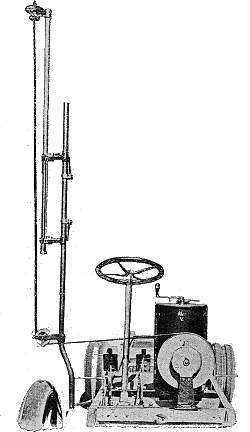
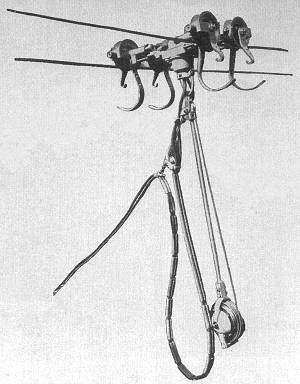
|
West Ham's First Trolleybus
By John Prentice Part 3 |

|

|
|
The sprung drum used to tension the trolley cable and the tram-type controller. Note also the two brake pedals. |
The Stoll patent current collecting trolley showing the weighted "pendulum" used to keep it level on the wires. |
In 1904 in Vienna the ideas of Stoll, Lohner and Porsche were combined to develop a trolleybus system using Carl Stoll's overhead trolley and Lohner and Porsche's hub motors. The vehicles usually used two 20 horsepower (later 25 or 28 h.p.) hub motors on the rear wheels. They had bodies with 16 to 24 seats, usually the latter, and typically weighed just over 5 tons when loaded with passengers. About 8 metres of flexible cable from the trolley was wound onto a sprung drum probably to Ludwig Stoll's design and usually housed under the front bonnet, although on some early cars mounted on a front stanchion. Power was collected from the drum by laminated copper brushes and slip rings. Tram type controllers were hand operated and had six speed positions, three with the motors in series, three with them in parallel, using air cooled resistances mounted under the floor (later versions, including the West Ham car, had seven speeds with four series positions). In addition there were three rheostatic electric brake positions. As with a tram controller there was a reversing key which could also be used in the event of failures to cut out one motor. There were two foot brakes which operated onto the wheel rims, one having a ratchet for parking. Lighting was from the overhead supply with an accumulator to provide for emergencies.
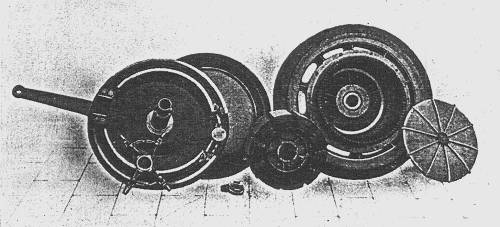
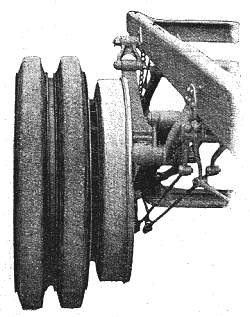 To a design patented by Ferdinand Porsche and Ludwig Lohner in 1902, this is the Austrian built hub motor as used in Cedes-Stoll trolleybuses, in parts (above) and assembled in a wheel (right). Later some were manufactured by Johnson and Phillips in Charlton, London and by Cedes Electric Traction Ltd. at Stamford Hill.
To a design patented by Ferdinand Porsche and Ludwig Lohner in 1902, this is the Austrian built hub motor as used in Cedes-Stoll trolleybuses, in parts (above) and assembled in a wheel (right). Later some were manufactured by Johnson and Phillips in Charlton, London and by Cedes Electric Traction Ltd. at Stamford Hill.
It is stated that the trolleybuses would run at 15 m.p.h. on a level road and when fully loaded with passengers would draw only 15 amps of current at 500 volt DC to obtain this speed. On a 5% gradient they drew 42 amps at 9.5 m.p.h. and on a 10% gradient 66 amps at 7.5 m.p.h. There was a more powerful variant with four-wheel drive for hilly routes etc., examples in Vienna and Judenburg having seats for 22 and pulling a 20 seat trailer, the trailer having solenoid actuated brakes.
The overhead fittings included a design for a crossing that would allow the trolleybuses to cross a tramway, which was used in Paris 1912-14, was demonstrated in Hove in 1914 and used from 1914 in Keighley. Overhead masts were usually of an iron lattice construction at a maximum of 32 metres apart, although ordinary tram standards with span wires or brackets and in country areas wooden poles were sometimes used. The two trolley wires were set at 5.75 metres from the ground and each wire had lightning conductors provided separately.

This drawing has been extracted from the Cedes-Stoll British patent number 7305 of 1913 and shows the arrangement for a Stoll trolleybus / tramway crossing. The twin over-running Stoll trolleybus wires on "J" hangers ran above the tramway overhead wire, which had a 7/8" gap to allow the Stoll power cables to pass through.
European production was in Vienna, initially by Österreichische Daimler-Motoren-Gesellschaft under the name of Daimler-Stoll. The official address of the company was Florianigasse 55, Vienna 8. In 1906 the patent rights were sold to the Emil Jellinek's French company Société Mercédès Électrique (Mercédès was the name of Jellinek's daughter) who took over the Austrian company a year later and went on to market complete trolleybus systems (including overhead and power supplies) as well as electric lorries, under names such as Cedes-Stoll, Lohner-Stoll, Mercédès-Électrique, Electro-Daimler-Stoll and Mercedes-Stoll. Their first line was opened in Gmünd, northern Austria in July 1907 using two front-wheel drive vehicles.
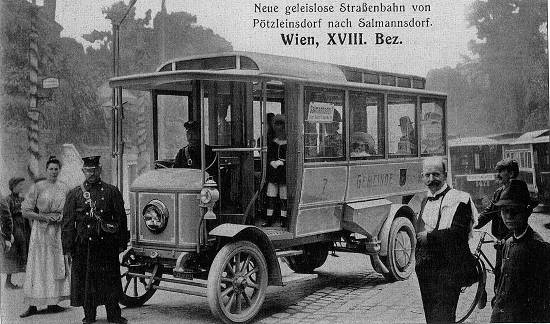
Here we have a view of Vienna's Daimler-Stoll trolleybus 7 at Pötzleinsdorf on the route from there to Salmannsdorf. In the background are two tramway trailer cars (the one on the left is s2 class 1478, reconstructed from a horse car built in 1872) at the terminus of tram route 41 from Mölkerbastei (Schottentor), for which the trolleybus route was a feeder.
Trolleybuses in the early years were not designed as tram replacements, but as feeders and for light traffic routes. For instance, a typical Mercedes-Stoll system built for Vienna itself was opened on 16th October 1908 and ran for 1.9 km as a feeder from the terminus of tram route 41 at Pötzleinsdorf to the outlying district of Salmannsdorf. At first it had just four 24-seat front entrance trolleybuses, with the four-wheel drive trolleybus and trailer previously mentioned added a year later. This whole installation was built at an initial cost of just over £7,000 including the original four vehicles, a small price to pay in comparison to building a similar sized tramway. It is believed that the West Ham demonstration trolleybus was tested on the Vienna line before being shipped to the UK.
![]() Go now to Part 4
Go now to Part 4
![]() Return to Start
Return to Start